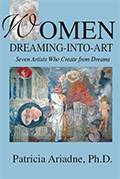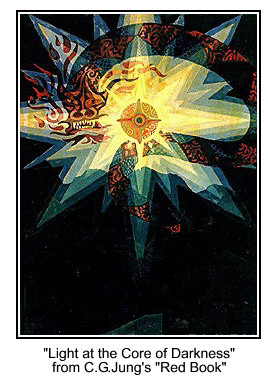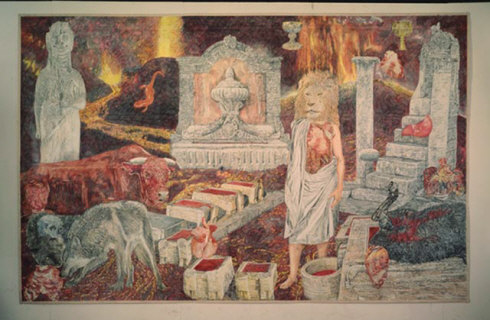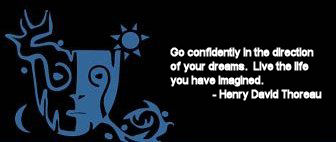|

 Ann McCoy Introduces Dr. Patricia Ariadne's
Ann McCoy Introduces Dr. Patricia Ariadne's
Women Dreaming into Art:
Seven Artists Who Create from Dreams
Galde Press; ISBN: 1-8880090-69-4
Ann McCoy is an award-winning artist and writer who has exhibited her work around the world and in places like the Metropolitan Museum of Art, High Museum, Art Institute of Chicago, Indianapolis Museum of Art, and the San Francisco Museum of Modern Art. She was one of the artists featured in Dr. Ariadne's book, and she offers us this introduction to the work.
Patricia Ariadne, a Jungian psychotherapist has produced a scholarly and groundbreaking book. It is the first to chronicle the contribution of pioneering Jungian artists working with ritual, performance, healing practices, sound, dance, large scale installations, and music. "These artists' lives are evidence that to honor our dreams is to conceptualize ourselves as part of a spiritual order: we no longer seek religion but live it." Books on art by Jungians have usually fallen into several categories: the ARAS (Archive for Research in Archetypal Symbolism) approach with singular images from art history; books written by an analyst with a patient's drawings on a theme (the mandala or the black Madonna for example); art therapy, or commentaries on the drawings of the insane. Any artwork shown in Jungian Institutes tends to fall into the category of easel-sized painting of archetypal imagery often by patients or analysts.
 Jung's own relationship to living artists was problematical. Although he worked out many of his theories with drawings in his Red Book, his writing on Picasso and James Joyce is probably his very worst. Picasso is put in a category with unfeeling madmen and, sadly, Jung overlooks the vast range of alchemical symbolism in Picasso's art (about which art historians have published volumes). Joseph Henderson's work on Jackson Pollock was withdrawn from the world of Jungian discourse after ethics questions surfaced regarding the sale of the drawings. In spite of Pollock's work with both Joseph Henderson and Violet de Laszlo, art historians like William Ruben have completely dismissed Pollock's relationship to Jungian thought. Jung's own relationship to living artists was problematical. Although he worked out many of his theories with drawings in his Red Book, his writing on Picasso and James Joyce is probably his very worst. Picasso is put in a category with unfeeling madmen and, sadly, Jung overlooks the vast range of alchemical symbolism in Picasso's art (about which art historians have published volumes). Joseph Henderson's work on Jackson Pollock was withdrawn from the world of Jungian discourse after ethics questions surfaced regarding the sale of the drawings. In spite of Pollock's work with both Joseph Henderson and Violet de Laszlo, art historians like William Ruben have completely dismissed Pollock's relationship to Jungian thought.
Artists working with Jung's ideas are excluded from most Jung Institutes, including six of the artists in this book. Artists make a mess as they enter in bearskins and disturb training programs focused on credentials, or disrupt lecture series designed to get patients for analysts. Artists are wild and wooly and usually don't have Ph.D.'s, and are myth breakers who wander outside safe boundaries. Many a Jungian trainee could benefit from a week in Austria at artist Herman Nitsch's Orgies Mysteries Theatre, where the taurobolium is actually performed and participants bathe in bull's blood. Hermann Nitsch is also a scholar who knows the Mysterium Coniunctionis as well as any analyst I have met, and actually lives it.

"Conversations with Angels", by Ann McCoy
Majdanek Muzeum, Lublin, Poland 2004
Patricia Ariadne is an analyst and a scholar of the humanities. Her knowledge of alchemy, poetry, literature, and the history of performance and dance is extraordinary. She understands the importance of Jungian ideas being "lived" in the arts in a way that I have never encountered in the Jungian world. She has done an in-depth interview of each artist, and has written about their unique contribution in a scholarly and sympathetic manner. None of the women have been described as "disturbed" or "insane". Ariadne values the positive and healing contribution of each artist's pioneering work, and writes about it in a thoughtful and scholarly manner. She is able to enter the process with each artist, and she explores the wide range of each artists work.
Mary Beth Edelson performed feminist rituals in the seventies. In one ritual she put Elaine Pagels in a womb like structure. The woman performed a ritual on Elaine, and she became pregnant after years of infertility. Edelson also worked with Marija Gimbutas and did rituals in the Goddess cave in Eastern Europe. Her work with women's healing rituals and dreams comes out of her knowledge of Jungian psychology and women's history. She has collected dreams in public rituals. Her work spans a forty-year period, and is considered seminal in feminist anthologies.
Carolee Schneemann (author of Imaging Her Erotics recently published by M.I.T. Press) chronicles her forty five-year career in film making, performance, essay writing, and a multiplicity of artists productions. In a series of dreams and synchronic events she describes how she healed herself from advanced cancer. Her work on the erotic, the body politic, and the sacred nature of sexuality would be of great benefit to anyone trying to escape the Christian repression of the body and sexuality. Her work should be required reading for all former divinity students in Jungian training. Her contribution as an essayist is also significant. She made the first erotic films from a woman's point of view, and redefines the erotic in a feminist perspective.
Deena Metzger is an author and playwright who has worked with James Hillman. Her play Dreams Against the State examines the future in a fascist state where dreams are forbidden. Her belief that dreams are letters from the gods propels all of her creative work. Recently she has been involved with non-Eurocentric healing practices and their relationship to dreams. Metzger feels that Jungian psychology acted as a foundation, and now her work is going more in the direction of indigenous healing practices. She is now more interested in non-Western approaches.
Anna Halprin is a dancer and choreographer and founder of the San Francisco Dancers' Workshop. She has created workshops for people with life threatening illnesses such as HIV/AIDS and cancer. She leads workshops in universities, museums, and religious centers. In one of her dances, the participants slept in dream-wheels, practiced incubation, and shared dreams. Her interest in shared dreams and their relationship to dance and healing comes out of her own healing from cancer. Her contribution has been to bring movement and dreams together. She dances the dream and explores the healing potential involved in this act.
Pauline Oliveros is an internationally acclaimed composer and musician. Her sound pieces and ceremonial theater pieces have been seen all over the world. "On some level music, sound, consciousness and religion are all one, and she would seem very close to that level." Oliveros often incorporates in her work visual images taken from her dream journals. In one of the most touching passages in the book, Patricia Ariadne shares a dream she had of Pauline Oliveros before she went to interview her. Ariadne and Oliveros are dancing with a dog in a field in the dream, and Oliveros is wearing special shoes. Ariadne feels the dream tells her how the work of Oliveros is grounding, something she needs in her life. Rather than treating the artist as an insane person, Ariadne feels she has something to learn from the artist. Patricia Ariadne is able to enter into the unconscious process of the artist in a way that is extraordinary, compassionate, and celebratory.
Christine Downing is a writer, scholar, and psychotherapist who has written on the Goddess. Downing has taught at the C.G. Jung Institute in Zurich, has a Ph. D, and has lectured at Pacifica. Her writing on the Goddess and feminist topics are mostly related to the ancient world and topics like women's mysteries, Demeter, and Persephone. Her book, Psyche's Sisters, examines themes of sisterhood, and the sister as a part of the self and shadow. Of all of the women in the book, she is the only one who has been involved in the Jungian world of institutes and is also an analyst.

"Coeur de Lion" by Ann McCoy
My own work in the book comes out of thirty years of Jungian analysis both in the United Sates and Zurich with C.A. Meier. My main interest is alchemy, and drawing the alchemical processes in large-scale pencil works. Each mural sized work takes a year to complete and is a map of a psychological process. I also work with installations and fairy tales. Recently I have been part of a film series on artists and psychoanalysis by a Freudian foundation where I was the lone Jungian. Much of my work has been on the feminine, including work on the negative mother and the healing of that relationship. (Ann McCoy's website)
Patricia Ariadne has done all of the women involved a great service. She has attempted to help the Jungian world understand the contribution of artists working with Jung's ideas who are also expanding the boundaries of that discourse. In the art world Jung has been dismissed; the ideas of Freud, Lacan, Guattari, and others are the prevailing discourse. The artists involved with Jung's ideas are double outcasts, first from the pervasive Freudian Marxist theoretical discourse dominating the art world, and also from the Jungian community which has little interest in the work of living artists. Artists are the ones who often "give the myth modern dress", expanding the world of Jungian ideas in ways that are unknown to scholars and analysts. Artists live their work and dreams, and embody the ideas in new ways. Hopefully Ariadne's book will be a beginning of building a bridge between Jungian artists and the Jungian community. The unconscious is a messy place, and the horned Carolee Schneeman with her face painted in menstrual blood taking a scroll from her vagina might bring the discourse back to life and help enliven institutes obsessed with accreditation and certificates.
Return to Passages Menu
Subscribe to the Passages e-zine
|

